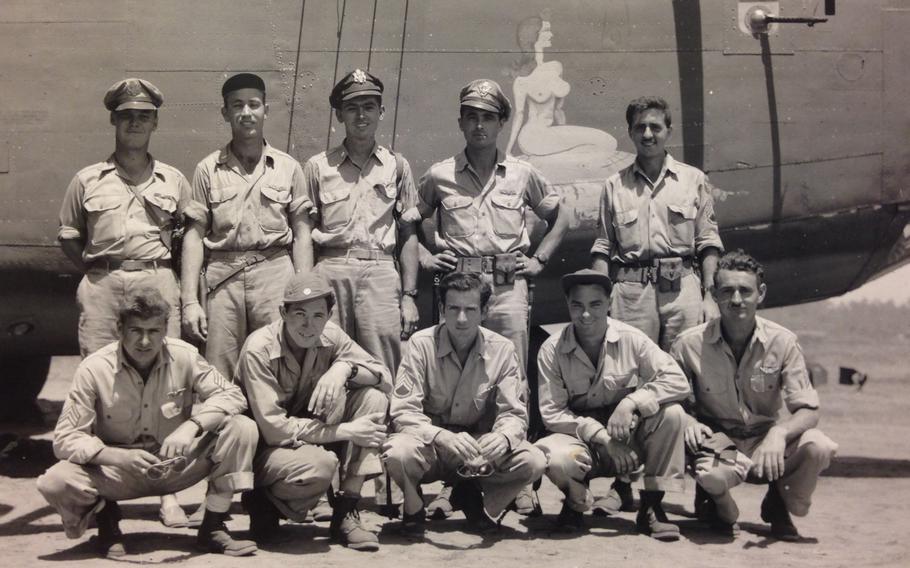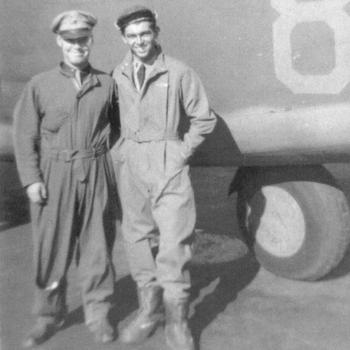
Crew of the “Heaven Can Wait” bomber in Papua New Guinea. 2nd Lt. Thomas V. Kelly Jr. is the middle figure in the back row, standing with his .45 pistol in a shoulder holster. (Courtesy of Scott Althaus)
For many years after 2nd Lt. Thomas V. Kelly Jr. was killed in World War II, his parents kept his empty bedroom like a shrine to their only son.
In the local cemetery, they placed a memorial stone etched with his name and an image of his Army Air Forces bomber. His body had been lost when the plane was shot down and sank to the bottom of the ocean.
Kelly was 21. His mother, Theresa, saved his letters, including one that arrived weeks after his death. When his mother, father, Thomas Sr., and sister, Betty, died, they were laid to rest by his stone.
On Memorial Day, 81 years after he was killed off the coast of New Guinea, and two years after his remains were recovered from the underwater crash site, Kelly is to be buried beside his family in Livermore, Calif.
The burial is the culmination of a 12-year search by his relatives — launched on Memorial Day 2013 — that was joined by the Navy, the Defense POW/MIA Accounting Agency (DPAA) and the nonprofit partnership Project Recover.
“The thought of watching his casket go in where my mom and her parents are … it’s going to be something,” Kelly’s niece, Diane Christie, said. “We’re all going to be a big pile of mush.”
“For somebody that none of us knew,” she said.

Heaven Can Wait navigator Donald W. Sheppick, 26, left, with Kelly, the bombardier, in an undated family photograph. The remains of both men have been recovered. (Family photo)
The wreckage was found in 2017 by a Project Recover team, which used the family’s extensive research to zero in on the site.
In 2023, elite Navy divers descended in a pressurized diving bell and over several weeks recovered Kelly’s remains along with those of three other members of the B-24’s 11-man crew.
The plane was in 225 feet of water, said Lt. Cmdr. Ted Kinney, the Navy’s officer in charge. The men wore dive suits heated with hot water, and breathed air that was a mixture of oxygen and helium.
He said he participated in one of the dives and found a piece of a human skull as he went through the wreckage. “It was the first piece of osseous material that we discovered,” he said.
“So we knew we were on the right spot, and we knew that we were going to be able to find people and bring them home,” he said in telephone interview Tuesday.
“It was incredibly humbling,” he said.
Kelly was the plane’s bombardier. The divers recovered a ring that said “bombardier” on it, and experts are certain it was Kelly’s. Also recovered were his dog tags and the dog tags of two other crewmen.
“I’m just feeling a lot of gratitude right now,” said Scott Althaus, Kelly’s first cousin once removed and a professor at the University of Illinois at Urbana-Champaign. He headed the family’s quest to learn the details of Kelly’s fate and did months of research on the project.
“I’m sure I will be flooded with emotions,” he said of the burial in a recent telephone interview. “How can it be that our family is living what should be an impossible story? What made it possible was many people along the way stopping and remembering.”
Another niece, Kathy Borst, said: “I can’t even begin to believe that it’s truly happening.”
“Only four sets out of 11 of the remains were found,” she said in a recent telephone interview. “What were the odds that we were going to be one of them?”
The project also produced “hard moments,” she said. During a government briefing about the identification, one expert showed the family an image of a crack in Kelly’s skull where his head had struck a part of the plane as it crashed.
“I start visualizing, ‘Oh, this is what happened when my uncle died,’” she said. “It was very, very, very painful.”
“I’m really glad my mom was not alive” she said. (Borst’s mother was Kelly’s sister.) “I don’t think that would have made this a worthwhile thing for her.”
Now they can rest together, she said: “They couldn’t be reconnected ever in life, but they could be lying in the same ground.”
Kelly’s remains arrived Friday at the San Jose Mineta International Airport from the DPAA’s laboratory in Hawaii, where they were officially identified via DNA in November. The plane was greeted by relatives, an honor guard and a water salute from airport fire equipment.
He is to be buried in St. Michael’s cemetery in Livermore, about 40 miles east of San Francisco, after a religious service at St. Michael’s Catholic Church.
It’s the same church where a requiem Mass was said for him after he was declared dead in 1944, according to his family and an old newspaper report.
Kelly’s B-24 was nicknamed “Heaven Can Wait.” (The name probably came from the title of a 1943 movie starring the actor Don Ameche.) Painted on the nose was a racy image of a woman with angel’s wings.
On March 11, 1944, the plane was shot down during a bombing mission off the north coast of the island of New Guinea, just north of Australia.
A crewman on another plane saw “Heaven Can Wait” catch fire. Three men jumped or fell out. The tail section broke off. The bomber plunged into water and sank near a remote bay off the Bismarck Sea in the southwestern Pacific Ocean.
There were no survivors. The 11 men on board were declared killed in action, and their bodies were ruled unrecoverable.
Four months earlier, Kelly and three of his buddies had attended a Thanksgiving dinner for 23 people at his parents’ home on South L Street in Livermore. On a lighthearted guest register the four signed in as crewmen on a “Big Ass Bird.”
After that Thanksgiving, Kelly’s family never saw him again, his relatives said.
But two weeks after his death, they got a letter addressed “Dearest Mom, Dad & Betty.”
He had written it two days before his final mission. He talked about sleeping late, getting cigarettes and ice cream, and watching movies at his base. There was no word about combat.
“Give my love to everyone & please be happy & take care of yourselves,” he wrote. “All my love always, your loving son, Tom.”
Kelly’s two nieces and nephew, Tom Borst, said they knew little about him while growing up.
Christie said they knew only that he hadn’t come home from the war. She knew that their mother, his sister, hated the song “I’ll be home for Christmas,” because Kelly had hoped to be home by Christmas 1944.
When they visited their grandparents’ house, “we’d go into his bedroom,” she said. “It was a little bit of a shrine. And we all remember it … I can see it vividly. It was always a little bit dark.”
Kathy Borst said she remembered visiting the cemetery “most Memorial Days of my childhood.” She said she was too young to know why.
In one of his final letters home, Kelly told his family: “I don’t want you to feel sorry for me. I’m just telling you to appreciate what you have. … The men fighting here for everyone, they’re doing it for your freedom.”